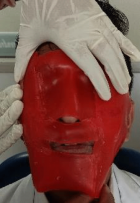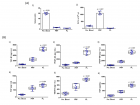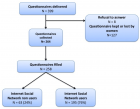Abstract
Research Article
Prediction of neonatal and maternal index based on development and population indicators: a global ecological study
Sedigheh Abdollahpour, Hamid Heidarian Miri and Talat Khadivzadeh*
Published: 07 December, 2021 | Volume 4 - Issue 4 | Pages: 101-105
Introduction: Although worldwide maternal and neonatal mortalities have decreased,
but Achieving sustainable development goals remains an unfinished agenda and global challenge. This study aimed to predict neonatal and maternal index based on development and demographic indicators.
Methods: In this ecologic study, the dependent variables were Maternal mortality ratio (MMR), Neonatal mortality rate (NMR), and Under 5 Mortality Rate (U5MR) and the independent variables were Gender gap index (GGI) and its four components, human development, life expectancy, total fertility rate, and population growth. Data conducted using international secondary data published data bases of health metrics from 2016 to 2018 in 149 countries from WHO (World Health Organization), World Economic Forum, UNICEF (United Nations Children's Fund), and UNDP (United Nations Development Programme). Data analysis was performed using correlation model in Stata version 14.1 software.
Results: In this study, economic participation and total fertility rate are positively and educational attainment, Human Capital Index and life expectancy are negatively associated with MMR. Human Capital Index, Educational attainment, and Life expectancy are negatively associated with NMR. Economic participation and total fertility rate are positively and educational attainment, Human Capital Index and life expectancy are negatively associated with U5MR.
Discussion: To reduce the maternal and neonatal mortality rate, it is important to pay attention to indirect causes such as equal conditions for men and women to demographic and population indices such as economic participation, educational attainment, Human Capital Index and life expectancy.
Read Full Article HTML DOI: 10.29328/journal.cjog.1001096 Cite this Article Read Full Article PDF
Keywords:
Ecologic study; Maternal mortality; Neonatal mortality; Under 5 mortality; Gender gap index
References
- World Health Organozation. Global Health Observatory (GHO) data. Infant mortality. Situation and trends. 2017. https://www.who.int/gho/child_health/mortality/neonatal_infant_text/en/
- Maternal mortality fact sheet No. 348. Geneva: World Health Organization; 2014 (http://apps.who.int/iris/bitstream/10665/112318/1/WHO_RHR_14.06_eng.pdf?ua=1
- World Health Organozation. Global Health Observatory (GHO) data. Neonatal mortality. Situation and trends. 2016. https://www.who.int/gho/child_health/mortality/neonatal_text/en/
- Strategies towards ending preventable maternal mortality (EPMM), World Health Organization. 2015.
- Evaluating the quality of care for severe pregnancy complications: the WHO near-miss approach for maternal health. 2011.
- Abdollahpour S HMH, Khadivzadeh T. The global prevalence of maternal near miss: a systematic review and metaanalysis. Health Promot Perspect. 2019; 9: 255-262. PubMed: https://pubmed.ncbi.nlm.nih.gov/31777704/
- Hulton L, Murray S, Thomas D. The Evidence Towards MDG 5. London, England. 2010.
- Economic UNDo. The Millennium Development Goals Report 2008. United Nations Publications; 2008.
- Rath S, Patnala S, Bosman SJ. Sustainable Development Goals and Addressing Non-communicable Diseases. Indian J Pharm Pract. 2016; 9: 67.
- World Health Organozation. Global Health Observatory (GHO) data. Under-five mortality. Situation and trends. 2018. https://www.who.int/gho/child_health/mortality/mortality_under_five_text/en
- Souza JP, Tunçalp Ö, Vogel J, Bohren M, Widmer M, et al. Obstetric transition: the pathway towards ending preventable maternal deaths. BJOG. 2014; 121: 1-4. PubMed: https://pubmed.ncbi.nlm.nih.gov/24641529/
- Alvarez JL, Gil R, Hernández V, Gil A. Factors associated with maternal mortality in Sub-Saharan Africa: an ecological study. BMC Public Health. 2009; 9: 462. PubMed: https://pubmed.ncbi.nlm.nih.gov/20003411/
- Girum T, Wasie A. Correlates of maternal mortality in developing countries: an ecological study in 82 countries. Matern Health Neonatol Perinatol. 2017; 3: 19. PubMed: https://pubmed.ncbi.nlm.nih.gov/29142757/
- Say L, Chou D, Gemmill A, Tunçalp O, Moller AB, et al. Global causes of maternal death: a WHO systematic analysis. Lancet Glob Health. 2014; 2: e323-e333. PubMed: https://pubmed.ncbi.nlm.nih.gov/25103301/
- Forum WE. The Global Gender Gap Report 2018. https://www.weforum.org/reports/the-global-gender-gap-report-2018
- Nations U. Department of Economic and Social Affairs, Population Division, World Population Prospects: The 2017 Revision. 2017.
- Global data - Monitoring ICPD Goals: selected indicators. 2016. (https://www.unfpa.org/sites/default/files/SWOP-2016.xlsx)
- Child Mortality Estimates: Country-specific neonatal mortality rate. Estimates generated by the UN Inter-agency Group for Child Mortality Estimation (UN IGME) in 2017. http://data.unicef.org
- Tajik P, Nedjat S, Afshar NE, Changizi N, Yazdizadeh B, et al. Inequality in maternal mortality in Iran: an ecologic study. Int J Prev Med. 2012; 3: 116. PubMed: https://pubmed.ncbi.nlm.nih.gov/22347608/
- Kazemi Karyani A, Kazemi Z, Shaahmadi F. The main determinants of Under 5 Mortality Rate (U5MR) in OECD countries: A cross-sectional study. Int J Pediatr. 2015; 3: 421-427.
- Almasi-Hashiani A, Sepidarkish M, Vesali S. The correlation of human development index on fertility and mortality rate: a global ecological study. Int J Pediatr. 2016; 4: 4071-4080.
- Abdollahpour S, Heidarian Miri H, Khamse FK, Khadivzadeh T. The relationship between global gender equality with maternal and neonatal health indicators: an ecological study. J Matern Fetal Neonatal Med. 2020; 14: 1-7. PubMed: https://pubmed.ncbi.nlm.nih.gov/32290738/
Figures:
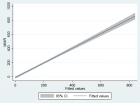
Figure 1
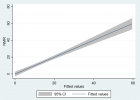
Figure 2
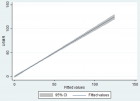
Figure 3
Similar Articles
-
Current anesthesıa for Cesarean SectıonDemet Dogan Erol*, Ismail Aytac. Current anesthesıa for Cesarean Sectıon. . 2018 doi: 10.29328/journal.cjog.1001011; 1: 061-066
-
Focused Antenatal Care in urban Ghana: A qualitative study into physical accessibility of maternal health services in Kwabre East MunicipalityAkowuah Jones Asafo*,Kwarteng Bernard Owusu. Focused Antenatal Care in urban Ghana: A qualitative study into physical accessibility of maternal health services in Kwabre East Municipality. . 2019 doi: 10.29328/journal.cjog.1001023; 2: 054-066
-
Maternal mortality and factors affecting it, among pregnant women in Abeokuta South, NigeriaTumilara Busayo Amoo*,Oyinkansola Sarah Ajayi. Maternal mortality and factors affecting it, among pregnant women in Abeokuta South, Nigeria. . 2019 doi: 10.29328/journal.cjog.1001025; 2: 071-078
-
Maternal, neonatal and children´s health in Sub-Saharan East AfricaJosef Donát*. Maternal, neonatal and children´s health in Sub-Saharan East Africa. . 2020 doi: 10.29328/journal.cjog.1001049; 3: 043-045
-
Maternal and perinatal outcomes of uterine rupture in Lubumbashi, Democratic Republic of CongoJacques Ngoy Kitenge,Olivier Mukuku*,Xavier K Kinenkinda,Prosper L Kakudji. Maternal and perinatal outcomes of uterine rupture in Lubumbashi, Democratic Republic of Congo. . 2020 doi: 10.29328/journal.cjog.1001067; 3: 136-141
-
Prediction of neonatal and maternal index based on development and population indicators: a global ecological studySedigheh Abdollahpour,Hamid Heidarian Miri,Talat Khadivzadeh*. Prediction of neonatal and maternal index based on development and population indicators: a global ecological study. . 2021 doi: 10.29328/journal.cjog.1001096; 4: 101-105
-
Severe preeclampsia at the University Hospital Center of Mother and Child (UHCMC) in N’djamena: Epidemiology and prognosisFoumsou L*,Kouamé A,Danmadji NL,Gabkika BM,Damthéou S,Aché H. Severe preeclampsia at the University Hospital Center of Mother and Child (UHCMC) in N’djamena: Epidemiology and prognosis. . 2022 doi: 10.29328/journal.cjog.1001099; 5: 009-012
-
Neonatal Mortality Rate among Twin and Singleton Births with the Gestational Age of 34-37 Weeks: A Population-Based StudySedigheh Hantoushzadeh, Kayvan Mirnia, Hananeh Sadat Sadeghi, Parvaneh Sadeghimoghadam*, Mohammad Aghaali, Mohammad Heidarzadeh, Abbas Habibelahi, Shima Rafiee, Mohammad Haddadi, Amir Naddaf. Neonatal Mortality Rate among Twin and Singleton Births with the Gestational Age of 34-37 Weeks: A Population-Based Study. . 2023 doi: 10.29328/journal.cjog.1001134; 6: 088-094
-
Comparative Analysis of HtrA3 and NGAL as Viable Biomarkers for Pre-eclampsiaSuraj Narayanan Chembukavu, Sana Syed Samreen, Pankaj Yadav*. Comparative Analysis of HtrA3 and NGAL as Viable Biomarkers for Pre-eclampsia. . 2023 doi: 10.29328/journal.cjog.1001135; 6: 095-100
-
COVID-19 Pneumonia in Pregnancy: A Retrospective Study on Maternal and Neonatal OutcomesBenlghazi Abdelhamid*, Belouad Moad, Hanane Dabdi, Bouhtouri Yassine, Messaoudi Hamza1, Benali Saad, Ait Bouhou Rachid, El Mangoub Fatima, Elhassani Mly El Mehdi, Kouach Jaouad. COVID-19 Pneumonia in Pregnancy: A Retrospective Study on Maternal and Neonatal Outcomes. . 2024 doi: 10.29328/journal.cjog.1001163; 7: 051-055
Recently Viewed
-
Enlarged Curvature, Torsion and Torque in Helical Conformations and the Stability and Growth of α-Peptide under the Isochoric and Isobaric Conditions: Variatonal OptimizationTarik Omer Ogurtani*. Enlarged Curvature, Torsion and Torque in Helical Conformations and the Stability and Growth of α-Peptide under the Isochoric and Isobaric Conditions: Variatonal Optimization. Ann Biomed Sci Eng. 2024: doi: 10.29328/journal.abse.1001032; 8: 039-058
-
Satellite-Based Analysis of Air Pollution Trends in Khartoum before and After the ConflictHossam Aldeen Anwer*,Abubakr Hassan,Ghofran Anwer. Satellite-Based Analysis of Air Pollution Trends in Khartoum before and After the Conflict. Ann Civil Environ Eng. 2025: doi: 10.29328/journal.acee.1001074; 9: 001-011
-
Chemical constituents and biological activities of Artocarpus heterophyllus lam (Jackfruit): A reviewSibi G*,Pranay Raja Bhad,Meeneri Vilas Bobde. Chemical constituents and biological activities of Artocarpus heterophyllus lam (Jackfruit): A review. Int J Clin Microbiol Biochem Technol. 2021: doi: 10.29328/journal.ijcmbt.1001019; 4: 005-009
-
Challenges in Y-DNA Recovery from Fabric: Effects of Environmental Degradation and Implications for Forensic CaseworkNaina Sharma,Surya Shekhar Daga*. Challenges in Y-DNA Recovery from Fabric: Effects of Environmental Degradation and Implications for Forensic Casework. J Forensic Sci Res. 2025: doi: 10.29328/journal.jfsr.1001090; 9: 117-124
-
Expression of Collagen VI, Anticollagenase, Laminin, MM9, Claudins 1 and 5, N and E Cadherins in Choroid Plexus TumorsMartha Lilia Tena-Suck, Laura Chavez Macias, Erick Gómez-Apo, Alma Ortiz Plata, Carmen Rubio*. Expression of Collagen VI, Anticollagenase, Laminin, MM9, Claudins 1 and 5, N and E Cadherins in Choroid Plexus Tumors. Arch Pathol Clin Res. 2023: doi: 10.29328/journal.apcr.1001037; 7: 020-027
Most Viewed
-
Feasibility study of magnetic sensing for detecting single-neuron action potentialsDenis Tonini,Kai Wu,Renata Saha,Jian-Ping Wang*. Feasibility study of magnetic sensing for detecting single-neuron action potentials. Ann Biomed Sci Eng. 2022 doi: 10.29328/journal.abse.1001018; 6: 019-029
-
Evaluation of In vitro and Ex vivo Models for Studying the Effectiveness of Vaginal Drug Systems in Controlling Microbe Infections: A Systematic ReviewMohammad Hossein Karami*, Majid Abdouss*, Mandana Karami. Evaluation of In vitro and Ex vivo Models for Studying the Effectiveness of Vaginal Drug Systems in Controlling Microbe Infections: A Systematic Review. Clin J Obstet Gynecol. 2023 doi: 10.29328/journal.cjog.1001151; 6: 201-215
-
Prospective Coronavirus Liver Effects: Available KnowledgeAvishek Mandal*. Prospective Coronavirus Liver Effects: Available Knowledge. Ann Clin Gastroenterol Hepatol. 2023 doi: 10.29328/journal.acgh.1001039; 7: 001-010
-
Causal Link between Human Blood Metabolites and Asthma: An Investigation Using Mendelian RandomizationYong-Qing Zhu, Xiao-Yan Meng, Jing-Hua Yang*. Causal Link between Human Blood Metabolites and Asthma: An Investigation Using Mendelian Randomization. Arch Asthma Allergy Immunol. 2023 doi: 10.29328/journal.aaai.1001032; 7: 012-022
-
An algorithm to safely manage oral food challenge in an office-based setting for children with multiple food allergiesNathalie Cottel,Aïcha Dieme,Véronique Orcel,Yannick Chantran,Mélisande Bourgoin-Heck,Jocelyne Just. An algorithm to safely manage oral food challenge in an office-based setting for children with multiple food allergies. Arch Asthma Allergy Immunol. 2021 doi: 10.29328/journal.aaai.1001027; 5: 030-037

HSPI: We're glad you're here. Please click "create a new Query" if you are a new visitor to our website and need further information from us.
If you are already a member of our network and need to keep track of any developments regarding a question you have already submitted, click "take me to my Query."






